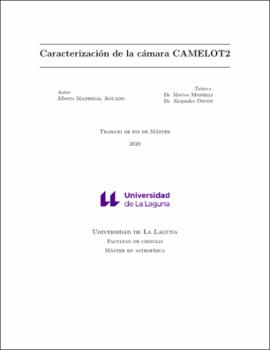Caracterización de la cámara CAMELOT2
Author
Madrigal Aguado, AlbertoDate
2021Abstract
This work reflects the results of the complete characterization of CAMELOT2 (from in
spanish CAmara MEjorada Ligera del OT) and is focused on determinate the best way
to carry out the observations and pull out the best of this telescope. CAMELOT2 is the
common user instrument of the IAC80 telescope, at the Teide Observatory. The IAC80
telescope has 82 cm of aperture and at its cassegrain focus is placed CAMELOT2, an
instrument with a detector made by Spectral Instruments. It is a 4kx4k back illuminated
CCD which operates in the optical wavelength range. It has a huge collection of lters which
includes SDSS griz, Johnson UBVRI, Str omgrem uvby standards and many narrow lters.
The pixels size is 15 which implies a pixel scale on-sky of 0.336 arcsec/pix. The theoretical
eld of view must be 22 x 22 arcsminutes2 but, due to the vignetting caused by the lters,
the useful eld of view is 10.6 x 10.6 arcminutes2. Due to this problem, all the analysis
had to been carried out in the unvignetted region. In order to get a low readout time and
low readout noise, the common use observing modes have 4 channels. Because of this, we
performed all the tests for each individual channel and then we computed the mean for the
4 channels. A verifcation of the linearity response in all common observing modes was made. An important amount of images with at illumination and increasing exposure times were taken. It is clearly visible that all modes o er a satisfactory linear behavior. The saturation
counts for every mode were determined and the maximum at counts for every mode were
set to get the proper calibration at images. The unique way to check if the values of gain and readout noise are close to those provided by the manufacturer is from the images taken with CAMELOT2. A set of bias and ats images were taken and the values of gain and readout noise for the common observing modes were measured. This test makes sure that the results obtained are very similar to those provided in the datasheet of the CCD and, therefore, it is not su ering degradation. Despite the CCD is cooled to -105ºC, we have tested that the dark current is low enough and does not represent a high noise contribution. Again, many dark images with increasing exposure times were taken and analyzed. We found that, even in images with long exposure times (30 minutes), the dark current contribution is negligible and it is no necessary to take calibration dark images.
The efect of the shutter opening/closin, time has been analyzed. This mechanical part
of the camera blocks a tiny fraction of light at the beginning and at the end of the exposures.
A set of images with very low exposure time were taken. In the very rst images is clearly
seen the pattern of the shutter. It shows radial structure and depends on the polar angle in
the image. It is hard to x its e ects and the best way to minimize them is to take science
images with exposure times longer than the total time the shutter takes to open and close.
The PSF shape of the stars in all the surface of the detector was checked. A set of stars
in images with di erent lters were selected along the eld of view. The ellipticity of these
stars were represented versus their position in the CCD, trying to gure out where comes rom the miss alignment. Further research is needed to solve this problem although our
results point to a miss alignment between the primary and secondary mirrors.
With the data provided by the previous sections an update of the exposure time calculator
was made. Due to all the factor involved in the process of taking an astronomical
image, it has not been possible to get the exact star lux, sky lux and the signal to noise
ratio as they appear in a real image. It has been bounded the error sources and changes
will be made. Finally, a practical test has been carried out using the previous results. Despite that the IAC80 is a small telescope, it is possible to obtain low-brightness images with the proper observation strategy. In this case, after 85 hour of observations, a low-brightness image of NGC1035 and its companion DF4 was obtained. The images were taken in SDSS rgi lters following a precise dithering pattern. After obtaining the images, an optimized data
reduction procedure was applied paying special attention to systematic errors, telescope
mirrors dirt and CCD pixel to pixel response. To ful ll this, a at image was made using
the science images themselves. The results are images with a limit surface magnitude near
to 29 magnitudes per arcsecond2 that can highly contribute to relevant current researches
such as the presence of a galaxy lacking dark matter.
Concluding this summary, small telescopes can still contribute to astronomy specially
taking into account that they can o er more observation time per target at a lower cost
as compared with their big brothers. The price to pay is that more nights are needed for
some given projects. Finally, to reach good science results it is necessary to know all the
parameters and characteristics about the detector like linearity, gain, noise sources and
other particularities and prepare well the observations.





